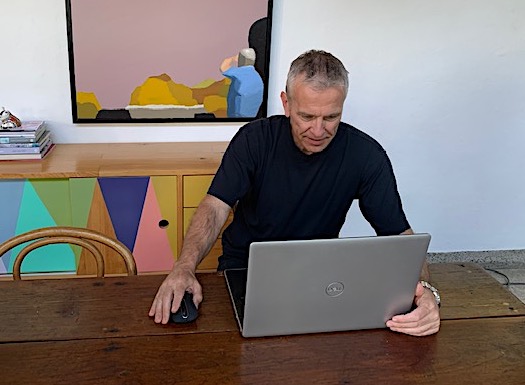Geraint Davies talks streaming apps, smart speakers and podcasts
Geraint Davies was at ARN for just over ten years, before leaving recently as a result of covid cutbacks.
In his most recent job, as Head of iHeartRadio Australia he gained a unique perspective on streaming, online audio and podcasting. He shares some of his insights with radioinfo.
Since iHeartRadio launched in 2013 it has become one of Australia’s top radio/streaming apps, along with the ABC’s Listen app and CRA’s RadioApp. iHeartRadio Australia has about four times as many users as RadioApp.
“It’s a very crowded market with many apps delivering streams, podcasts and catchup radio,” he says, pointing out that there are many more apps in competition to the main Australian apps.
“CRA is doing a really successful job in stopping apps scraping the internet for our streams and publishing them through their own apps, but it is a bit like the whack-a-mole game, once you got rid of one, another pops up. I think we got rid of about 35 to 40 third party apps that were using Australian radio URLs to rebroadcast under their own banner…
I think the push by the ABC, SCA, Nova and ARN to get people to use either the RadioApp or station apps is a good thing and a sign of industry unity.”
TuneIn is the world’s biggest aggregator app of radio streams. What are your thoughts on their business model?
“They were one of the first organisations to do this. Their business model has changed over time because globally more and more broadcasters are pulling their feeds off TuneIn now, it may be beneficial for some smaller broadcasters, but others are not happy with the way TuneIn is monetising them… I think their influence in certain radio sectors will decline, but may increase in others because they’re now introducing subscription services and sports stations. I think that their business model is changing to rely less on terrestrial broadcast streams and more on specialist audio.
“They have a huge list of radio stations. They sell that list to developers who use it to add hundreds of thousands of radio stations to their service or smart speaker. TuneIn is the go-to place for developers who want to use live radio streams.”
How do they monetise other people’s streams?
“At first they did a pre-roll before the stream and display ads, they have global scale and big numbers so that was working for them in their early days, but they seem to be changing that now. If stations didn’t like it they could technically ask TuneIn to remove the pre-roll, but they are hard to contact and trying to get them to do things is quite tough.”
With changes in ownership and strategy at iHeartRadio America, the company used its app to achieve national reach and scale for advertisers at a time when it needed to evolve its business strategy. Australia was able to follow suit.
“We found ourselves piggybacking on something huge… they were saying ‘radio is a national business with a huge reach’ and repositioning radio in America as a reach giant rather than selling by individual city ratings in New York, L.A. and so forth… Australia’s market is a bit different, but there are still national brands like Harvey Norman, Kentucky Fried, Oporto and so forth so the model can work in Australia too.”
One of iHeartRadio’s unique features, which makes it different from other radio live stream apps is that it also has music playlists streams. This positions it as a direct, free competitor to Spotify, Pandora, Deezer and other music streaming services. While Davies acknowledges that aspect of iHeartRadio, he credits iHeartRadio’s music events business more than music streams for its success.
“In the US, their event strategy has made them a global music event Goliath with the ability to pull together stars for wherever. That strategy put radio back on the map as a relevant and trendy medium…
“The streaming music side of the app is relatively small in comparison to live radio streams… 70-80% usage of the iHeartRadio Australia app is live radio streams.”
In many countries smart speakers use TuneIn’s radio streams as the default when someone asks for a station. In Australia, this is not the case, with RadioApp and iHeartRadio being an important source for smart speaker radio listening.
“In the last three years, radios have to come back into the house via smart speakers, showing that radio’s mix of music and talk is still an entertainment format that people want to hear… we need to maintain radio’s relevance or else a whole generations of people will move on, so this is helping to maintain what was a slowly decreasing share.”
Not every app or radio streaming service is going to guarantee that your station will be heard on smart speakers.
“You need the scale and size of a big provider to properly deliver your streams to smart speakers. Amazon and Apple had weekly calls with iHeartRadio to make sure that Siri and Alexa would work, because they realized if they didn’t work it would be a bad experience for their users.”
One of the smartest things that our commercial industry did in Australia was to launch the radio app then negotiate hard with the smart speaker providers to make sure that it was the default search app when people requested a radio station, and that it had many different varieties of name that people might request. Davies believes this has been an important element in radio gaining good traction in Australian smart speakers.
Forward thinking radio companies are reinventing themselves as audio businesses. While acknowledging that live linear radio is still strong they see that repackaging catch-up audio and investing in podcasts is going to be part of their business strategy in the future. It will ensure audiences can get what they want in different ways and companies can find new methods of monetizing their audio products.
Davies says that new delivery methods will also deliver more data for advertisers.
“We will see radio sales moving from the broadcast model where we don’t know exactly who’s listening to a service where we have significant amounts of data about your audience … that puts us in the digital selling space and allows us to fight against the likes of Facebook and Google.”
Unlike some other unscrupulous companies, the radio industry does not covertly gather information from users.
“Radio apps generally gather anonymous basic information if users are not logged in. If people choose to log in, they are asked for more specific information, but not personal information. We usually ask for postcode, gender, maybe your email and your year of birth, this is enough for advertisers to address specific audience segments.
“What is even more interesting for programmers is that apps can give minute by minute information on listening habits. “For instance, we could see that this person, say, listens to KIIS but they also listen to Triple J. You can’t advertise and triple j, so why not buy KIIS to reach that audience. You can catch them when they’re listening to KIIS, mostly between 5:00 and 6:00 p.m. Monday to Friday… If they listen to music on the app, you can also see that maybe they like heavy metal music and start to merge these data sets in ways that might interest advertisers.”
Davies says it doesn’t matter that you don’t drill down too far into areas where people may be sensitive to privacy issues.
“The more filters you put on something the less options you have and therefore you need a very big funnel at the top in order to give the advertiser sufficient volume of audience at the bottom… There is enough information for the radio industry to show that it is becoming a more dynamic medium, and that information can be extrapolated back into listening habits on broadcast radio to give advertisers a good snapshot of who they can reach.”
Podcast advertising is also evolving. From the early days of live read ads, ad insertion is now the next opportunity for advertisers.
“At first, about 80% of all revenue from podcasting had been from announcer read delivery stitched into the podcast, like ‘thanks to Sam for sponsoring today’s show.’ That type of delivery is authentic, sometimes cheesy, but effective. To do ad insertion well you need to keep that feel but use the technology to update the ads or rotate advertisers so listeners continue to enjoy that podcast. Be careful you’re not just putting in ads that abruptly interrupt the listener’s pleasure in that podcast.”

Geraint Davies can be reached at [email protected]
Subscribe to the radioinfo podcast on these platforms: Acast, Apple iTunes Podcasts, Podtail, Spotify, Google Podcasts, TuneIn, or wherever you get your podcasts.




